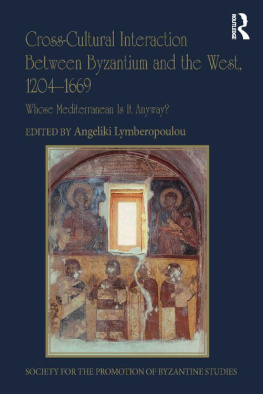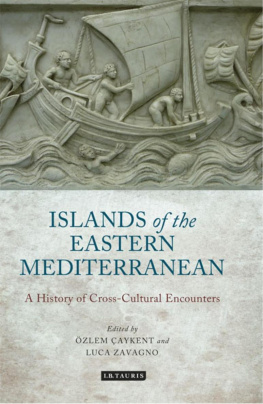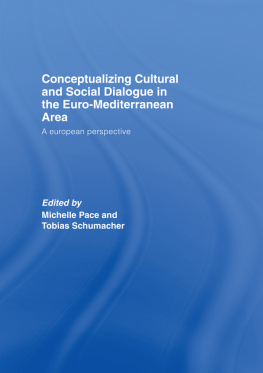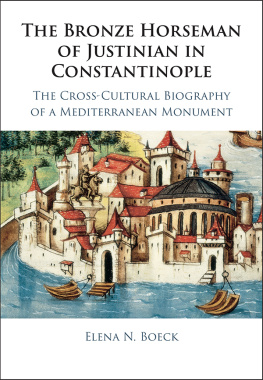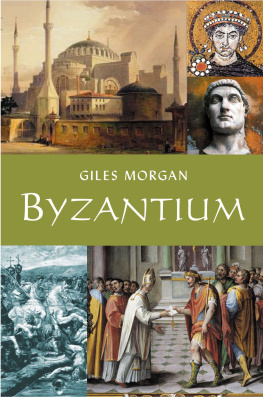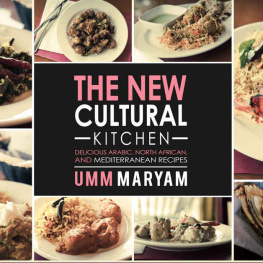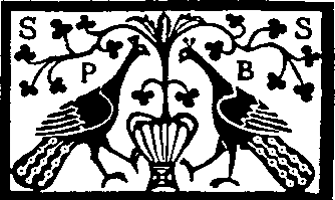CROSS-CULTURAL INTERACTION BETWEEN BYZANTIUM AND THE WEST, 12041669
The early modern Mediterranean was an area where many different rich cultural traditions came in contact with each other, and were often forced to co-exist, frequently learning to reap the benefits of co-operation. Orthodox, Roman Catholics, Muslims, Jews, and their interactions all contributed significantly to the cultural development of modern Europe. The aim of this volume is to address, explore, re-examine and re-interpret one specific aspect of this cross-cultural interaction in the Mediterranean that between the Byzantine East and the (mainly Italian) West. The investigation of this interaction has become increasingly popular in the past few decades, not least due to the relevance it has for cultural exchanges in our present-day society.
The starting point is provided by the fall of Constantinople to the troops of the Fourth Crusade in 1204. In the aftermath of the fall, a number of Byzantine territories came under prolonged Latin occupation, an occupation that forced Greeks and Latins to adapt their life socially and religiously to the new status quo. Venetian Crete developed one of the most fertile bi-cultural societies, which evolved over 458 years. Its fall to the Ottoman Turks in 1669 marked the end of an era and was hence chosen as the end point for the conference. By sampling case studies from the most representative areas where this interaction took place, the volume highlights the process as well as the significance of its cultural development.
Angeliki Lymberopoulou is Senior Lecturer in Art History (late and post-Byzantine art) at The Open University, UK. Her research interests focus on Venetian Crete (12111669) and the cross-cultural interactions and exchanges between Greek Orthodox and Roman Catholic Christians in the wider Mediterranean. She also examines Palaiologan Byzantine art produced in the major artistic centres during the last phase of the Empire Constantinople, Thessaloniki and Mystras. She is the author of The Church of the Archangel Michael at Kavalariana: Art and Society on Fourteenth-Century Venetian-Dominated Crete (London, 2006) and co-editor (with Rembrandt Duits) of Byzantine Art and Renaissance Europe (Farnham, 2013).
SOCIETY FOR THE PROMOTION OF BYZANTINE STUDIES
Publications 22
This series publishes a selection of papers delivered at the annual British Spring Symposium of Byzantine Studies, now held under the auspices of the Society for the Promotion of Byzantine Studies. These meetings began fifty years ago in the University of Birmingham and have built an international reputation. Themes cover all aspects of Byzantine history and culture, with papers presented by chosen experts. Selected papers from the symposia have been published regularly since 1992 in a series of titles which have themselves become established as major contributions to the study of the Byzantine world.
Also published in this series:
WONDERFUL THINGS
Byzantium through its Art
Edited by Antony Eastmond and Liz James
POWER AND SUBVERSION IN BYZANTIUM
Edited by Dimiter Angelov and Michael Saxby
EXPERIENCING BYZANTIUM
Edited by Claire Nesbitt and Mark Jackson
BYZANTIUM IN THE ELEVENTH CENTURY
Being in Between
Edited by Marc D. Lauxtermann and Mark Whittow
CROSS-CULTURAL INTERACTION BETWEEN BYZANTIUM AND THE WEST, 12041669
Whose Mediterranean Is It Anyway?
Edited by Angeliki Lymberopoulou
CROSS-CULTURAL INTERACTION BETWEEN BYZANTIUM AND THE WEST, 12041669
Whose Mediterranean Is It Anyway?
Papers from the Forty-Eighth Spring Symposium of Byzantine Studies, Milton Keynes, 28th30th March 2015
Edited by
Angeliki Lymberopoulou
First published 2018
by Routledge
2 Park Square, Milton Park, Abingdon, Oxon OX14 4RN
and by Routledge
711 Third Avenue, New York, NY 10017
Routledge is an imprint of the Taylor & Francis Group, an informa business
2018 The Society for the Promotion of Byzantine Studies
The right of Angeliki Lymberopoulou to be identified as the author of the editorial material, and of the authors for their individual chapters, has been asserted in accordance with sections 77 and 78 of the Copyright, Designs and Patents Act 1988.
All rights reserved. No part of this book may be reprinted or reproduced or utilised in any form or by any electronic, mechanical, or other means, now known or hereafter invented, including photocopying and recording, or in any information storage or retrieval system, without permission in writing from the publishers.
Trademark notice: Product or corporate names may be trademarks or registered trademarks, and are used only for identification and explanation without intent to infringe.
British Library Cataloguing-in-Publication Data
A catalogue record for this book is available from the British Library
Library of Congress Cataloging-in-Publication Data
A catalog record has been requested for this book
ISBN: 978-0-8153-7267-7 (hbk)
ISBN: 978-1-351-24495-4 (ebk)
Typeset in Times New Roman
by Florence Production Ltd, Stoodleigh, Devon, UK
SOCIETY FOR THE PROMOTION OF BYZANTINE STUDIES PUBLICATIONS 22
CONTENTS
Angeliki Lymberopoulou; appendix compiled with Fiona Haarer
PART 1
Byzantium and the West: Evidence from Crete
Diana Newall
Maria Constantoudaki-Kitromilides
Angeliki Lymberopoulou
Rembrandt Duits
PART 2
Byzantium and the West: Evidence from Cyprus
Tassos Papacostas
Michele Bacci
Ioanna Christoforaki
PART 3
Byzantium and the West: Evidence from the Peloponnese
Sharon E.J. Gerstel and Michalis Kappas
Andrea Mattiello
PART 4
Byzantium and the West: Evidence from the wider Mediterranean
Leslie Brubaker
Dionysios Stathakopoulos
Liz James
gnes Kriza
Leonela Fundi
Alex Rodriguez Suarez
Francesca Marchetti
Michele Bacci is Professor of Medieval Art History at the University of Fribourg, Switzerland. He is the author of several publications on the cultural and art-historical contacts between East and West in the Middle Ages and on the history of the religious practices associated with cult-objects and holy sites. His single-authored publications include Il pennello dellevangelista. Storia delle immagini sacre attribuite a san Luca (Pisa, 1998); Pro remedioanimae. Immagini sacre e pratiche devozionali in Italia centrale (secoli XIII e XIV) (Pisa, 2000); Lo spazio dellanima. Vita di una chiesa medievale (Bari-Rome, 2005); San Nicola il Grande Taumaturgo (Bari-Rome, 2009); The Many Faces of Christ: Portraying the Holy in the East and West, 3001300 (London, 2014); and The Mystic Cave: A History of the Nativity Church in Bethlehem (Brno, 2017).
Leslie Brubaker is Professor of Byzantine Art History, and Director of the Centre for Byzantine, Ottoman and Modern Greek Studies at the University of Birmingham. Her research focuses on the cult of the Virgin, iconoclasm, the relationship between text and image, manuscripts, and gender. Her numerous publications include

